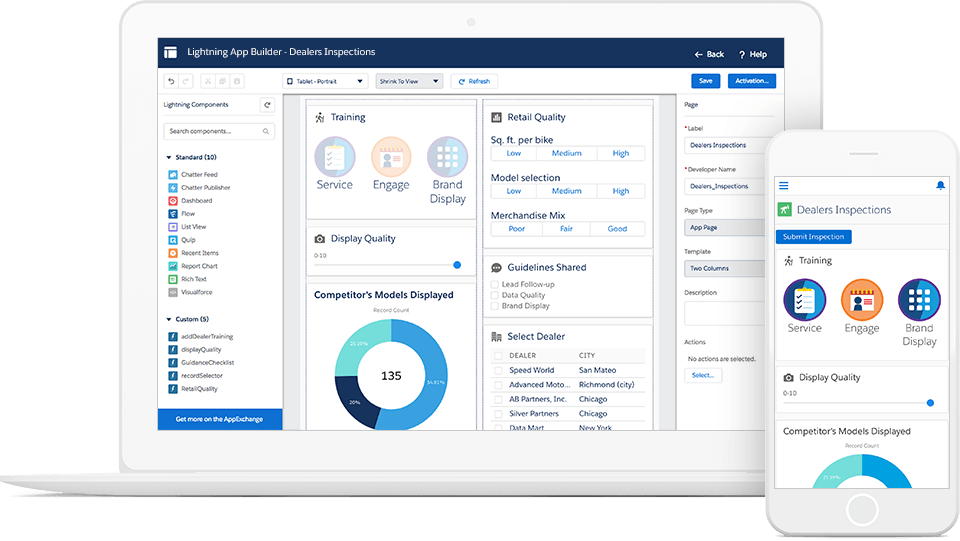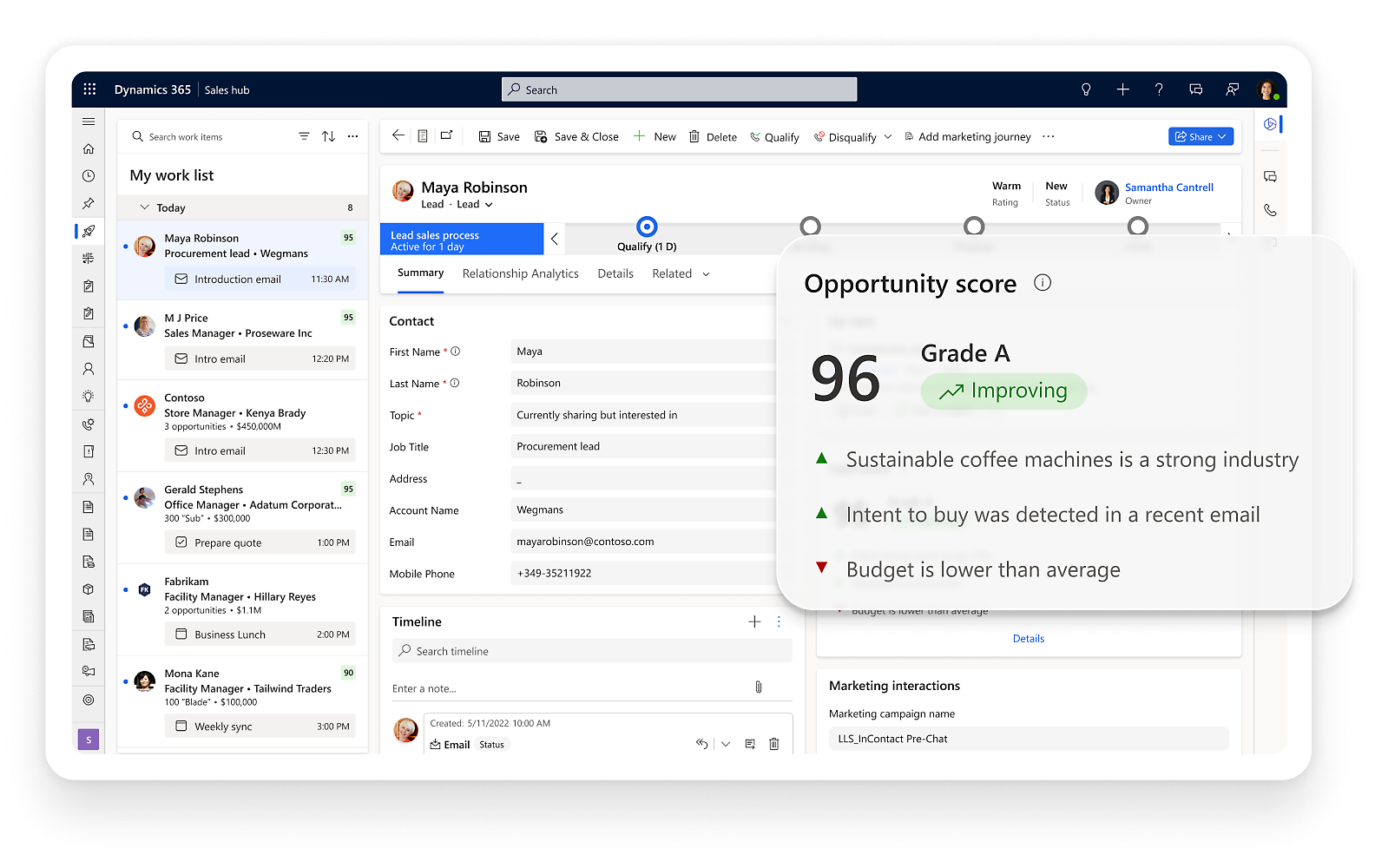
A tale of trials, debates, progress, and my first REAL CRM system, Dynamics 365 Sales CRM. My first run-in with a CRM wasn’t with Salesforce or HubSpot or anything sleek and shiny. It was with a hand-crafted, duct-taped-together system built on top of a decades-old ERP that lived on-prem long before the concept of SaaS ever existed. And you know what? For its time, it was brilliant, even with its glaring problems key folks pretended not to notice or address.
A multi-faceted individual took chaotic and vague direction and created a custom web interface; a private site that pulled data from the ERP and let the sales team manage calendars, track opportunities, and organize their workflow. It looked like magic and felt like innovation. But, as all things stitched together tend to go, it couldn’t scale. Worse, none of the systems talked to each other and the company depended 100% on this individual. If they left the scene, well there’s a certain creek the company would be up without a paddle.

Different sales tools had come and gone, but not one was able to hit the level of integration desired let alone offer a seamless, central source of truth. Everything lived in spreadsheets; sales activity, reporting, pipelines; tracked manually and duplicated constantly. That meant miscommunication, missed chances, and lots of “do we have that info?” moments. And eventually, after all the finger pointing and complaining had finally been exposed as the facade it was, the conversation eventually led to a dreaded crossroads: we needed a new solution.
 TL;DR Copilot Summary
TL;DR Copilot Summary
The post shares a candid journey of transformation from relying on a fragile, homegrown CRM system to successfully implementing Microsoft Dynamics 365 Sales. After years of inefficiencies, internal resistance, and failed vendor experiences, the team chose Dynamics 365 for its seamless Microsoft 365 integration and strong partner support. The journey involved technical hurdles, cultural shifts, and change management challenges, but ultimately led to improved automation, accountability, and user satisfaction. The author reflects on the lessons learned and how the experience inspired the launch of Alpyne 365, a Microsoft Partner business.
When “Better Than Nothing” Isn’t Enough

At the same time we were realizing this Frankenstein’s “CRM” couldn’t hold, an eCommerce store emerged during the process of swapping out the old, on-prem ERP. A story for another time, but it had this ability to tap into our ERP data. So, we ran with it. Created a subdomain. Built an interface that was similar, if not a step up from the old “CRM”; but with more modern bones. It wasn’t great, and did not have near the precautions in place that should be with data like this, but it was at least a step in the right direction.
I was involved with and also watched as so many amazing tools were created. Ones that were, often, unbelievably complicated to maintain and way overly customized. To the point it put the company in danger. It wasn’t sustainable. Everyone knew it; even if certain folks were trapped in denial or simply not eager to say it out loud. For the few of us who voiced concerns, those warnings fell on deaf ears to the point where it encouraged silence and adherence to, well, stupidity.
Hitting the Wall (and the Search Bar)

Eventually, it became impossible to ignore: the patchwork of systems wasn’t cutting it anymore. So what next? Welp, like most people these days, the guy taking the lead hit the web to explore service providers tied to the CRM platforms we were eyeing. We’d dabbled with Salesforce before; very lightly, and about 20 years ago; so it wasn’t a totally new name in the mix. But what we were actively using now was Microsoft 365, after a full migration off the Google stack, which made Dynamics 365 feel like the obvious frontrunner.
Of course, given how many internal tools we’d built over the years, the DIY option crept back in; again. There was also our ERP provider, who showed off their own CRM solution with what I can only describe as hopeful enthusiasm. But the second we took a closer look, it was clear: it wasn’t built to serve real needs. Native integration didn’t make up for clunky design and limited function.
We briefly tossed around some other names; HubSpot, Zoho, monday.com; but those conversations died quickly. Nothing played well with both our ERP and Microsoft 365 setup. Too many compatibility issues. Too many layers of complexity. The shortlist was shrinking fast.
Caution and Skepticism: Hard-Earned Lessons

When it came time to choose a CRM platform, we weren’t just nervous; we were borderline paranoid. The concerns were real: cost, compatibility with our existing stack, team buy-in, and whether the platform would actually work the way we needed it to. Those were practical worries.
But layered underneath that was something less tangible; baggage, for lack of a better word. Some of it was ego. Some of it was a tendency to see things through rose-colored glasses. Mostly, it was emotional residue from past tech relationships that left us burned.
We’d made choices before based on glossy sales pitches and charming reps, only to get the product in-house and realize we were on our own. The support vanished. The features didn’t match the demo. And we felt stuck; tricked, even.
So yeah, when it came to working with third-party vendors again, we were defensive. Skeptical. Probably overly cautious. But after learning those lessons the hard way, we couldn’t afford not to be.
Roundtable Roulette: Must-Haves vs. Nice-to-Haves

Next came the roundtable. We pulled in key folks from ops and sales and hashed out what features were absolutely essential versus the “nice to have if we’re lucky” stuff. And wow, was that painful. What counted as “critical” seemed to vary wildly depending on who you asked. There was a real lack of alignment and vision so this was a challenging situation to be in. Focus would continue to be a problem.
It was like trying to align puzzle pieces from entirely different puzzle sets. Everyone saw their department’s needs as the starting line, which made it tough to take a holistic view. Still, we were used to that type of chaotic back-and-forth, so we found our groove and created structured list of more generalized priorities. In essence, we jammed those puzzle pieces to make them fit into something resembling a picture if you squinted and unfocused your eyes.
The DIY Delusion (Again)

What tripped people up the most was cost; specifically, the cost of working with a certified partner. To me, the irony was plain as day. We’d already spent far more in internal labor hours building and maintaining our custom tools. Not to mention, those tools were deeply dependent on the people who built them. If they left, we were stuck. No documentation, no standardized process; just tribal knowledge and crossed fingers. Tribal knowledge was (and to some extent still is) a huge problem. How things were done successfully was stored in individual’s heads and defended.
And truthfully? That’s been the business’s Achilles’ heel since day one. The fragility of custom-built systems had always been a concern; but one that somehow never seemed urgent enough to solve. Until now.
We Had Options… Too Many, Honestly

We considered four CRM paths:
- Build our own again; Noble but naive. Once we ran the cost, it became a hard no.
- Use the ERP’s built-in CRM module; A disaster wrapped in clunky UI and questionable usability.
- Go with Salesforce; Sleek, powerful, and represented by someone who was impossibly charismatic.
- Explore Dynamics 365 Sales; A quieter option with unspoken confidence and native Microsoft 365 integration that we were already neck-deep in.
Initially, we liked the idea of maintaining control by using an open-source platform. But that was wildly ambitious and, ultimately, unrealistic. Also just a bad idea any way you sliced it, from sustainability and scalability perspectives especially.
Clingy-force
Salesforce, out of the gate, made the strongest impression. We really liked their graphics and shiny curb-appeal. They’re also a HUGE company so that meant a ton of resources would be available. Their rep dazzled us with features, demos, and promises. But then we asked the critical question: “What do we get with out of the box?” Cue awkward silence and the reveal that most cool features were behind extra paywalls; so steep they’d make a CFO break into cold sweats.

The whole pitch started to feel like smoke and mirrors, which we’ve been all too burned by in the past. So we paused. And while we paused, the Salesforce rep didn’t. They kept calling. Then, if they were told to stop, they’d call someone else in our org. Honestly, that wasn’t a personal gripe; I suspect it was just their company playbook. But still, it raised a red flag.
The more we looked into the post-sales process, the less attractive Salesforce appeared to be. That said, it’s still a wildly powerful platform but it wasn’t a good fit. And looking back, I’m glad this is how that played out because it wasn’t really all that different. I tend to look at their model like I do the Adobe model. Which isn’t my favorite. I feel like they both have wonderful products, but with shady and often anti-consumer tactics. But those are feelings, not facts. Can always change too. Meh.
Enter: Dynamics 365 Sales CRM and a Breath of Fresh Air

Around this time, we connected with a Dynamics 365 partner with a solid reputation. The difference was night and day. Patient, transparent, responsive; they answered our questions without handwaving. Even gave us a sandbox environment loaded with test data and some of our own, so we could see the platform in action.
For me, it was a quick sell. Dynamics had the integrations we needed with Microsoft 365, it fit our stack, and it didn’t feel like we were getting upsold at every turn. Not only did we have a solid partner to work with, we also had the backing of the wonderfully extensive Microsoft Learn platform, a wildly deep community, and, of course, Microsoft’s own in-house support.
The Decision Was Made… Eventually

You’d think we jumped on Dynamics right then. Not exactly. First there was an 18-month saga of discussions, debates, delay, and indecision. Eventually, we landed on Dynamics 365 Sales. For a variety of reasons. Main reasons included its ability to integrate with Microsoft 365 and our ERP as well as the wild possibilities of tools we could build with that platform in our back pocket. Getting access to a sandbox was a big help in making that decision because we could poke around to see what was available out of the box.
One day I was asked to lead the project. I wasn’t too surprised by this but I was still nervous and excited. More than anything, I was ready to build something right; without constant meddling and vague direction. There were still hurdles. Ugh, so many hurdles. So many rose-tinted glasses looking back at old systems. I remember one instance where an individual was going on about how the old system was so amazing. I paused and posed a question of the validity of their statement of its enormous value when we’re actively replacing it. I watched as the person appeared to have their brain short out and they got angry and loud and stormed off. Classic. There was a fair amount of that sort of nonsense of ego. I didn’t expect so much interference with regard to that. I was more focused on solving obvious problems and didn’t think I had to deal with a viper’s pit on the backend.
Culture Shift: From “Just Get It Done” to “Let’s Do It Right”
Building a great system was only part of the challenge. Getting people on board was tougher. The default mindset was “good enough is good enough.” Or worse, complete indecision and using “perfection” as an excuse. Ideas were often half-baked or left floating in the air, never to settle. We simply had to create clarity, structure, and momentum.

A perfect display of this was when we spoke to CRM providers during the discovery phase, it was chaos. Questions flew everywhere without any real rhyme or reason: “Can we automate this?” “Will this talk to that?” “How much does this cost?” “Do we need a partner long-term?” “How many licenses do we need?” “Can it do this thing?” “I don’t like the color.” “Who else uses this we can talk to?” It was almost like the rep was playing dodgeball and to their credit, they did a half decent job adapting. What we didn’t know was this system could be exactly what we wanted, we just had to define what that was. That was the irony here, we didn’t know what we wanted but we wanted it now.
Honestly, there wasn’t a real framework in place and a lot of stubbornness involved. Heck, we didn’t even know what we didn’t know. Turns out, that’s normal when you’re building something new; but boy is it messy. Good news is that this was addressed and began to force a meaningful shift towards meaningful questions and checks and balances. These items were put into the equation that weren’t there previously.
Reality Check: What We Were Dealing With

Before the CRM, accountability was a ghost. Sales activity was hard to track. Mistakes went unnoticed for ages. And recruiting? If someone had a slick interview presence, they could coast for six months before anyone realized they weren’t cutting it.
Without documentation or expectations, it was survival mode. And for a company with under 100 people, juggling that many responsibilities without a system was a recipe for burnout and missed growth.
We didn’t need more tools. We needed better systems.
The Setup and All Its Baggage

Getting the ERP data into Dynamics 365 was its own war. Sales history, accounts, contacts; it sounds simple, but we were untangling 40 years of neglected data practices. Some records were pristine. Most weren’t.
The tech team tried to apply logic and governance, but many people in ops and leadership didn’t want to hear about it; until those problems hit their doorstep.
Once that hurdle was cleared, we began documenting processes for leads and opportunities. And wow, did that spark debate. Everyone had their own language, interpretations, preferences. But we worked through it and struck a balance that felt solid; at least “solid enough” to launch with.
Building Structure: Champions, Deadlines, and Progress
I made it a point to have a plan from the start: timelines, deliverables, stakeholders, collaborators, ownership. We even created a system of “champions”; salespeople with tenure and a decent comfort level with tech. Their feedback during planning and after launch was incredibly valuable to the process. They helped us catch blind spots and ensure we weren’t building in a vacuum. Having a solid plan from the start was an unbelievable help because it helped us stay on task throughout the implementation.
Building the Blueprint: Lessons in Structure and the Power of Doing It Right

As bumpy as the process was, being forced to hit pause and look inward turned out to be one of the most valuable things we could’ve done. We had to ask hard questions: What actually makes sense for the business? How do we want people to operate within it? And how do we make that vision stick beyond just another tech rollout?
It was a strategic shift; though the word “strategy” began to feel like a four-letter word when discussed with certain parties. But the fact that we were even talking about long-term alignment was already a win.
We worked closely with our Microsoft Dynamics 365 partner, and after what felt like an endless cycle of revisions, debates, and “wait, let’s revisit that again,” we finally landed on a solid, structured plan. For the partner, this was out of the ordinary. Usually, they’re stuck hand-holding their clients through every step just to get a Statement of Work drafted. But because we had organized our needs and processes with surprising structure, the transition was seamless. It even mirrored their format; made everything easier.
Once the paperwork was signed, we dove in. And let’s just say; we weren’t their typical client. Unlike most orgs that rely heavily on the partner’s in-house devs, we had two incredibly technical team members (myself included) taking the reins of the development work. They were fine with that, but probably didn’t anticipate how drastically it would cut into their projected service hours. I think they ended up billing just $3,500 out of a $35,000 estimate; because we handled things internally, quickly, and confidently.
Rolling Up Our Sleeves: Technical Hands-On and a Fast Start
We worked with one of their consultants; sharp, slightly standoffish, with a lacking sense of humor that made it hard to pin down her vibe. At the time, Dynamics 365’s interface was mid-revision, so any time we asked how to adjust something, she had to revert us back to the old layout just to explain how things worked since she was unfamiliar with the new UI.
Which, fair enough, things happen, though I did note it. But, I mean, since we were going to maintain the system going forward, we needed clarity on where everything lived in the updated interface; not the legacy one. She admitted our dynamic wasn’t what she was used to; we could talk tech with her without oversimplifying, which was a breath of fresh air for both sides.

Once she gave us a rough tour and answered some lingering questions, we were off to the races. She began to slow us down when we asked her important questions and she had to consult with her own technical team. So with that dynamic in place, every time she checked in, huge portions of the CRM were already done. This wasn’t a typical process, but, for us anyway, it worked beautifully.
Where We Stumbled: Change Management Woes

What we didn’t crush? Change management. We were given tons of freedom and very little direction. Anyone tasked with creating training materials… well, let’s just say the results didn’t exactly inspire clarity. The shift from custom-built tools to Dynamics 365 felt overwhelming for a lot of folks. Not because the system was bad; but because the rollout was undercooked.
Still, once people got hands-on for a few weeks, light bulbs started going off. They saw how their work in Dynamics translated to dashboards, goals, and metrics; automatically. That’s when real buy-in started happening.
We did allow the old system to run parallel with the new one for a bit; to protect data, mostly. It had a sunset date, but leadership pushed to extend it, which caused more confusion than it solved. Some users refused to transition, and others got mixed messages from managers who hadn’t really learned the new system themselves. So there were the inevitable awkward calls, full of confidently wrong claims about how the system was “broken.” But we never let it turn combative; we just sorted it and kept going.
System Maintenance, Integration, and The Copilot Era

Maintenance was manageable overall. There were a few updates, some hotfixes, some minor annoyances. Then came the integration with Microsoft’s Copilot AI, Teams, and other Microsoft 365 tools; which added a whole new layer of opportunity. We built some powerful automation tools using these native features, and they honestly changed the game.
Feedback was glowing. People started calling Dynamics “the best system we’ve had in the company’s history.” Which, I’ll be honest, was gratifying.
The only downside? No real technology strategy in place. We were building cool stuff, but it wasn’t part of an overarching plan. So tools sometimes got built that no one used. Or they overlapped. Or they got forgotten because there were simply too many.
We always tried to raise the flag; encouraging leadership to think about long-term strategy so new systems and tools would serve a real purpose. Not everything needs to be shiny. It needs to be intentional.
Why I’m Sharing All This

I’m walking you through all the gritty, sometimes frustrating, often rewarding pieces of this journey because there are rifts you may not see coming. We didn’t. Most weren’t system-related. They were organizational. They were human.
That’s why change management matters. That’s why solid project planning matters. The more you structure things, document expectations, and give your people clarity, the more it pays off; in ways you’ll feel for years, not just weeks.
Part of the reason I’m laying all of this out; the good, the messy, the parts we’d love to redo; is because I’ve been in those shoes. Completely lost in unfamiliar territory, trying to make sense of jargon and promises. And I’ve also lived through the sting of trusting third-party vendors who promised the moon… and delivered dust. Or worse, handed over a watered-down version of what they pitched with a grin.
You’ve probably met the type: The salesperson is a dream; responsive, understanding, invested; right up until the sale closes. Then you get handed off, and suddenly you’re invisible. That is, until you mention switching vendors. Then everyone comes running.
It’s disheartening. And it’s exactly why decision-making gets clouded with anxiety, frustration, and second-guessing. I’ve made calls I was excited about, only to feel let down once momentum stalled. It’s human. It’s normal. But it doesn’t have to be inevitable.

That’s why I share this; not just to document the technical journey, but to show you the reasoning behind my own approach. I half-jokingly describe my methodology like this: “I’m a therapist with a developer’s toolkit.” It’s funny, but also… kind of true.
I make it a point to slow down, ask the right questions, and really listen; because my job isn’t to strong-arm anyone into adopting Microsoft 365 or Dynamics 365. It’s to help figure out whether they actually make sense for your team. In most cases, they do. But there are outliers, and that’s perfectly okay.
What matters is this: I care.
Now that sounds kinda “woo-woo” but I mean I genuinely care about your experience, your team’s sanity, and whether your workday feels like something worth showing up for.
Because honestly? Work should be intuitive. It should be energizing. It should multiply your efforts; not bog them down. Things don’t have to be perfect out of the gate, incremental changes can do wonders.
Every task you do should quietly trigger four or five others behind the scenes, so you can focus on progress, not process. That’s the kind of momentum I aim for. I call it 5X productivity. And when it’s working, it’s magic.
Overview & Conclusion
Eventually, we all realized the patchwork of systems wasn’t cutting it anymore. We explored various CRM options, including building their own again, using the ERP’s built-in CRM module, Salesforce, and Dynamics 365 Sales. After much debate and consideration, we chose Dynamics 365 Sales due to its seamless integration with Microsoft 365 and the support from a reliable partner.

The transition wasn’t without its challenges, especially in change management, but the new system brought significant improvements in automation, accountability, and overall efficiency. Fact. The wildly powerful features included further enhanced our operations, making Dynamics 365 Sales the best system the company had ever used.
Not sure where they’re at with that whole thing now, though I can speculate, but either way, they were set up to succeed and then some prior to me pursuing Alpyne full-time. I know this platform works and it works darn well. It can virtually change how a business operates overnight and scale alongside them. Oof, then factor in automations and forget about it. I mean, if my starting a Microsoft Partner business isn’t a testament to how incredible I believe the Dynamics 365 Sales platform to be, I don’t know what is! 😉



